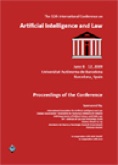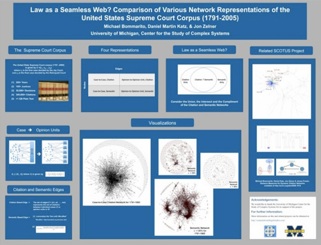





Distribution of United States Supreme Court Case Sizes
The Union, the Intersect and the Complement

“Opinion Units” within a Case
Law as a Seamless Web? Comparison of Various Network Representations of the United States Supreme Court Corpus
Michael Bommarito, Daniel M. Katz & Jon Zelner
Citation networks are a cornerstone of network research and have been important to the general development of network theory. Citation data have the advantage of constituting a well-defined set where the nature of nodes and edges is reasonably well specified. Much interesting and important work has been done in this vein, with respect to not only academic but also judicial citation networks. For example, previous scholarship focuses upon broad citation patterns, the evolution of precedent, and time-varying change in the likelihood that communities of cases will be cited. As research of judicial citation and semantic networks transitions from a strict focus on the structural characteristics of these networks to the evolutionary dynamics behind their growth, it becomes even more important to develop theoretically coherent and empirically grounded ideas about the nature of edges and nodes.
In this paper, we move in this direction on several fronts. We compare several network representations of the corpus of United States Supreme Court decisions (1791-2005). This corpus is not only of seminal importance, but also represents a highly structured and largely self-contained body of case law. As constructed herein, nodes represent whole cases or individual 'opinion units' within cases. Edges represent either citations or semantic connections. As our broader goal is to better understand American common law development, we are particularly interested in the union, intersect and compliment of these various citation networks as they offer potential insight into the long-standing question of whether 'law is a seamless web'? We believe the characterization of law’s interconnectedness is an empirical question well suited to the tools of computer science and applied graph theory. While much work still remains, the analysis provided herein is designed to advance the broader cause.
Semantic Similarity of Supreme Court Decisions at Differing Thresholds 1791-1865













